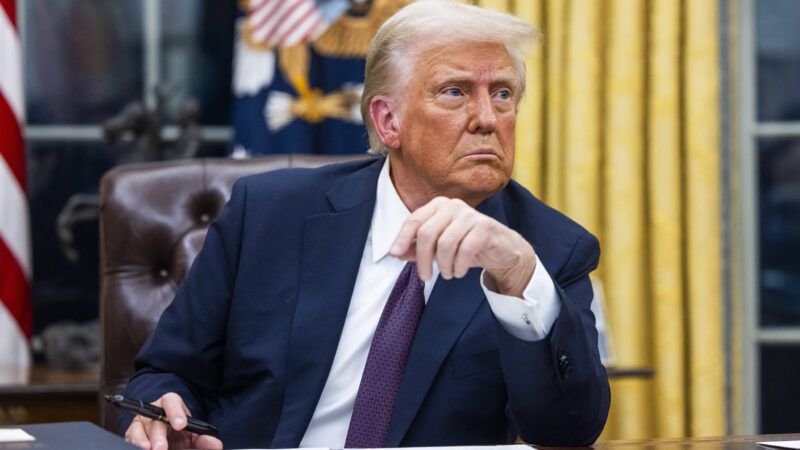Trump Has Good Reason To Complain About Limits on His Ability To Fire Executive Officers
His position is grounded in concerns about the separation of powers that presidents of both major parties have raised for many years.

Donald Trump likes to fire people, and he resents congressional constraints on that presidential prerogative. While Trump's opponents may view that attitude as one more manifestation of his autocratic instincts, his complaint is grounded in legitimate concerns about the separation of powers that presidents of both major parties have raised for many years.
A century ago, the Supreme Court held that Congress overstepped its constitutional authority when it decreed that presidents could remove "postmasters of the first, second, and third classes" only "with the advice and consent of the Senate." Based on extensive historical analysis, the majority concluded that Article II of the Constitution "grants to the President" the "general administrative control of those executing the laws, including the power of appointment and removal of executive officers."
In that case, it was a Democratic president, Woodrow Wilson, who was asserting that power by dismissing a postmaster in Portland, Oregon. Nine years later, the Court addressed a similar controversy involving another Democrat, Franklin Roosevelt, who had fired a member of the Federal Trade Commission (FTC) appointed by his Republican predecessor.
The commissioner's restrained view of the FTC's mission was inconsistent with Roosevelt's policy agenda, which was the reason the president gave for dismissing him. This time, the Supreme Court sided with Congress, which had said an FTC commissioner "may be removed by the President for inefficiency, neglect of duty, or malfeasance in office."
Reading that language as a limit on the president's power, the Court nevertheless upheld it, reasoning that FTC commissioners, unlike postmasters, were not "purely executive officers." Rather, the FTC was a "nonpartisan" panel of "experts" with "predominantly quasi judicial and quasi legislative" functions that was meant to be "independent of executive authority."
The Supreme Court implicitly recognized the difficulties with that approach in 1988 and 2010, and in 2020 it ruled that Congress had violated the separation of powers by putting the Consumer Financial Protection Bureau (CFPB) under the command of a single director whom the president could remove only for "inefficiency, neglect of duty, or malfeasance in office." Although the majority distinguished that arrangement from the one upheld in 1935, which involved a "multimember" commission that supposedly did not "wield substantial executive power," its logic cast doubt on the viability of that precedent.
The CFPB decision reaffirmed that "the entire 'executive Power' belongs to the President alone," which means he must have "power to remove—and thus supervise—those who wield executive power on his behalf." The majority also conceded that "the Court's conclusion that the FTC did not exercise executive power has not withstood the test of time."
The following year, the Court ruled that the principle it had defended in the CFPB case also condemned the structure of the Federal Housing Finance Agency, which like the CFPB was run by a single director, whom the president could remove only "for cause." By the same logic, the Trump administration argues, the president should have unlimited power to fire the head of the Office of Special Counsel, an investigative and prosecutorial agency charged with protecting federal employees from prohibited personnel practices.
At this stage of that case, the president's lawyers are not questioning the constitutionality of independent agencies like the FTC. But the Supreme Court may ultimately revisit that issue in this case or another involving Trump's assertion of presidential power.
The CFPB decision "repudiated almost every aspect" of the Court's ruling in the case that Roosevelt lost, Justice Clarence Thomas wrote in a partial concurrence joined by Justice Neil Gorsuch. They think the Court should explicitly overturn that 1935 precedent, which they say blessed "unaccountable independent agencies" that "exercise vast executive power outside the bounds of our constitutional structure."
They have a point. Under the Constitution, the federal government consists of three distinct branches: legislative, executive, and judicial. In recognizing an amalgam that is independent of presidential control, the justices effectively authorized a fourth branch of government that the Framers never imagined.
© Copyright 2025 by Creators Syndicate Inc.


Show Comments (43)